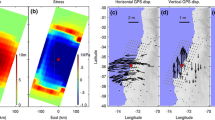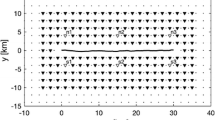Abstract
To maintain a stable and computationally feasible inverse problem, standard methods of inversion of ground motions for slip distribution on earthquake faults have to limit the size of the fault-discretization grid, with no clearly established criteria for setting the cell size. The subfault dimensions typically scale with earthquake magnitude. Also, the solution of a linear matrix equation, being the basis for the standard inversion techniques, assumes the slip weight on subfaults to be the only rupture parameter to solve for. This approach does not consider the fact that fault radiation is controlled by two independent rupture parameters – the slip U and peak slip rate vm – except at very low frequencies. These two parameters trade off with each other. Sensitivities of slip images to the selection of the grid and the assumption of a particular slip velocity (through a subfault’s rise time) cause ambiguities in the inverted models. Such sensitivities can be investigated by discretizing the representation integral of elasticity. For a heterogeneous fault, containing both a deterministic and a stochastic components, the subfault size of approximately 3 × 2.5 km leads to significant unphysical oscillations in the radiated ground-velocity pulse, caused by imprecise representation of the continuous integral; any coarser grid will cause distortions of the true slip distribution. The trade-off between U and vm results in offsetting large changes in subfault slip by relatively minor changes in slip velocity. The consequences of inadequate choices of mesh size and fixing the value of slip velocity (via slip duration), inevitable in the formulation of the matrix inversion, are the distortions of true slip of unknown severity. The artifacts produced are exacerbated by the use of the triangular slip-velocity function, compared to the omega-square one, as well as by the retention of only the far-field terms in the matrix equation.






Similar content being viewed by others
Data availability
No data were used in the paper. All inferences were made through the analyses of the respective equations and literature sources as indicated.
References
Aagaard, B. T., Brocher, T. M., Dolenc, D., Dreger, D., Graves, R. W., Harmsen, S., Hartzell, S., Larsen, S., & Zoback, M. L. (2008). Ground-motion modeling of the 1906 San Francisco earthquake, part I: validation using the 1989 Loma Prieta earthquake. Bulletin of the Seismological Society of America, 98, 989–1011.
Aagaard, B. T., & Heaton, T. H. (2004). Near-source ground motions from simulations of sustained intersonic and supersonic fault ruptures. Bulletin of the Seismological Society of America, 94, 2064–2078.
Aki, K., & Richards, P. G. (1980). Quantitative seismology. San Francisco: W. H Freeman and Company.
Beresnev, I. (2013). Reflections on frequency dependence in earthquake-source inversions. Natural Hazards, 66, 1287–1291.
Beresnev, I. A. (2001). What we can and cannot learn about earthquake sources from the spectra of seismic waves. Bulletin of the Seismological Society of America, 91, 397–400.
Beresnev, I. A. (2003). Uncertainties in finite-fault slip inversions: To what extent to believe? (A critical review). Bulletin of the Seismological Society of America, 93, 2445–2458.
Beresnev, I. A. (2017a). Factors controlling high-frequency radiation from extended ruptures. Journal of Seismology, 21, 1277–1284.
Beresnev, I. A. (2017b). Simulation of near-fault high-frequency ground motions from the representation theorem. Pure and Applied Geophysics, 174, 4021–4034.
Beresnev, I. A. (2022a). Equivalence between ωn source time functions and those proposed from dynamic finite-source modeling. Bulletin of the Seismological Society of America, 112, 1886–1893.
Beresnev, I. A. (2022b). The strongest possible earthquake ground motion. Journal of Earthquake Engineering, 26, 563–572.
Beresnev, I. A., & Atkinson, G. M. (1997). Modeling finite-fault radiation from the ωn spectrum. Bulletin of the Seismological Society of America, 93, 67–84.
Chen, Y.-T., Zhang, Y., & Xu, L.-S. (2019). Inversion of earthquake rupture process: theory and applications. Rivista Del Nuovo Cimento, 42, 367–406.
Gallovič, F., & Brokešová, J. (2004). On strong ground motion synthesis with k-2 slip distributions. Journal of Seismology, 8, 211–224.
Hartzell, S., & Helmberger, D. V. (1982). Strong-motion modeling of the imperial valley earthquake of 1979. Bulletin of the Seismological Society of America, 72, 571–596.
Hartzell, S., Liu, P., Mendoza, C., Ji, C., & Larson, K. M. (2007). Stability and uncertainty of finite-fault slip inversions: application to the 2004 Parkfield, California, earthquake. Bulletin of the Seismological Society of America, 97, 1911–1934.
Hartzell, S. H., & Heaton, T. H. (1983). Inversion of strong ground motion and teleseismic waveform data for the fault rupture history of the 1979 Imperial Valley, California, earthquake. Bulletin of the Seismological Society of America, 73, 1553–1583.
Heaton, T. H. (1982). The 1971 San Fernando earthquake: a double event? Bulletin of the Seismological Society of America, 72, 2037–2062.
Hisada, Y. (2001). A theoretical omega-square model considering spatial variation in slip and rupture velocity. Part 2: case for a two-dimensional source model. Bulletin of the Seismological Society of America, 91, 651–666.
Wells, D. L., & Coppersmith, K. J. (1994). New empirical relationships among magnitude, rupture length, rupture width, rupture area, and surface displacement. Bulletin of the Seismological Society of America, 84, 974–1002.
Yoshida, Y., Ueno, H., Muto, D., & Aoki, S. (2011). Source process of the 2011 off the Pacific coast of Tohoku Earthquake with the combination of teleseismic and strong motion data. Earth, Planets and Space, 63, 565–569.
Acknowledgements
The author is indebted to two anonymous reviewers for the comments on the manuscript.
Funding
No funding was provided for the completion of this study.
Author information
Authors and Affiliations
Contributions
IAB has contributed to this work.
Corresponding author
Ethics declarations
Conflict of interest
The authors declare no competing interests.
Additional information
Publisher's Note
Springer Nature remains neutral with regard to jurisdictional claims in published maps and institutional affiliations.
Rights and permissions
Springer Nature or its licensor (e.g. a society or other partner) holds exclusive rights to this article under a publishing agreement with the author(s) or other rightsholder(s); author self-archiving of the accepted manuscript version of this article is solely governed by the terms of such publishing agreement and applicable law.
About this article
Cite this article
Beresnev, I.A. Uncertainties in Finite-Fault Slip Inversions, Part II: Fault Discretization and Parameterization of Slip Function. Pure Appl. Geophys. 180, 59–68 (2023). https://doi.org/10.1007/s00024-022-03216-4
Received:
Revised:
Accepted:
Published:
Issue Date:
DOI: https://doi.org/10.1007/s00024-022-03216-4




